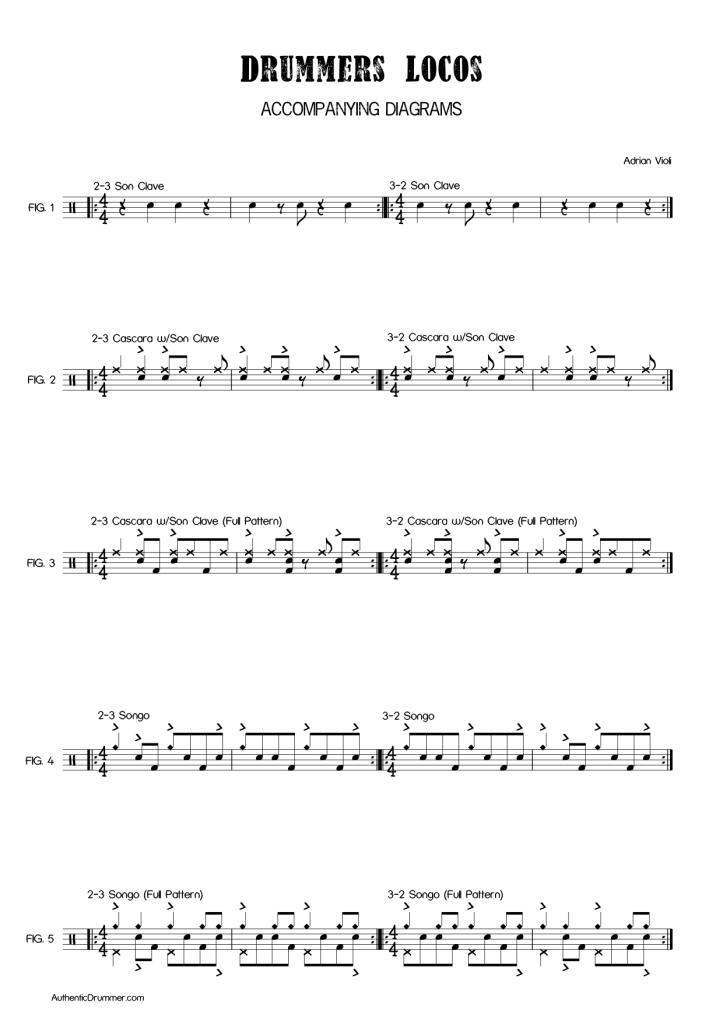
I thought I’d shed some light on something that a lot of drummers are interested in but haven’t quite given a go yet – Latin music. Now, the term ‘Latin’ can refer to a wide variety of styles and that would be a whole different article. No, today I want to concentrate on Cuba and primarily Salsa – from the drummer’s perspective.
Ask any traditionalist and they’ll tell you there’s no place for the drum set in Salsa music. The reality is that the drums are an essential part of the rhythm section and many Latin bands also play Pop tunes and need the drummer so the rhythms of Salsa needed to be interpreted for the drum set and work with Congas, Timbales and Bongos. Therefore, here is a very basic insight into what the drummer could play when accompanying a band playing a Salsa tune. We’ll cover some patterns to play for the verse of a tune and the chorus.
CLAVE AND CASCARA
The word ‘clave’ (pronounced ‘Clah-Vair’) literally means ‘Key’ or ‘Code’ in Spanish and is the foundation of all the patterns played by the percussionists in Salsa music. Furthermore, the patterns are written to fit over and around the clave. Generally, the clave pattern can be played using a rim-click on the snare drum or a wood block to mimic real claves. The clave pattern is presented in 2 ways – 2-3 or 3-2. This system refers to the how the notes are split between bars, for example, a 2-3 clave pattern would have two notes in the first bar and three notes in the second. A 3-2 clave would be the exact opposite (Figure 1).
Using the clave on the drums involves putting it with some other patterns. The ‘Cascara’ is a rhythm that is played on the timbales, on the sides of the shells, and can be emulated on the drum set by playing it either on the hi-hat or side of the floor tom. The cascara is joined with the clave to form a two-handed pattern that is generally used during the verse of a tune (Figure 2). Adding the bass drum pattern on 2+ and 4 ties in with what the bass guitar would be playing (Figure 3). You can use this pattern for the verse of a tune.
SONGO
The Songo is actually a pattern created especially for the drum set and fits perfectly over all the other percussion rhythms for a chorus groove. The dynamic is louder and more intense. Depending on the band will depend on whether there is a person to cover what is known as the ‘Bongo Bell’. This is a large cowbell that drives the band during the chorus emphasising the downbeat. If the bongo bell pattern is present the drummer can play this part on the ride cymbal or hi-hat. Otherwise, it is common to mount a cowbell off the bass drum and play with the right hand. The Songo can be simplified or extended (Figure 4 and 5). To take it a step further, you can substitute some the snare drum hits for toms, other cowbells, or hi-hat with the left hand.
THOUGHTS
Some drummers such as Horatio Hernandez and Antonio Sanchez will play the clave in the left foot on a separate cowbell/woodblock/pedal set up. This frees up the left hand to play other cowbell patterns or experiment. You can also set up timbales on the drums to play the cascara on the real thing if there is no timbale player. There are many other patterns and avenues to ponder with regard to this style of music but these two patterns (Cascara w/Clave and Songo) got me through my first Latin gig. Be patient, listen to Latin music to get the vibe and enjoy.
CHECK OUT THE AUTHENTIC DRUMMER SALSA VIDEO DRUM LESSONS HERE


great article Adrian, always room to learn, cheers, also love yr playing on Sharkmouth….. got me realy thinking about opening up space in my blues attack, which is what I do most and I guess best, cheers again ..steve